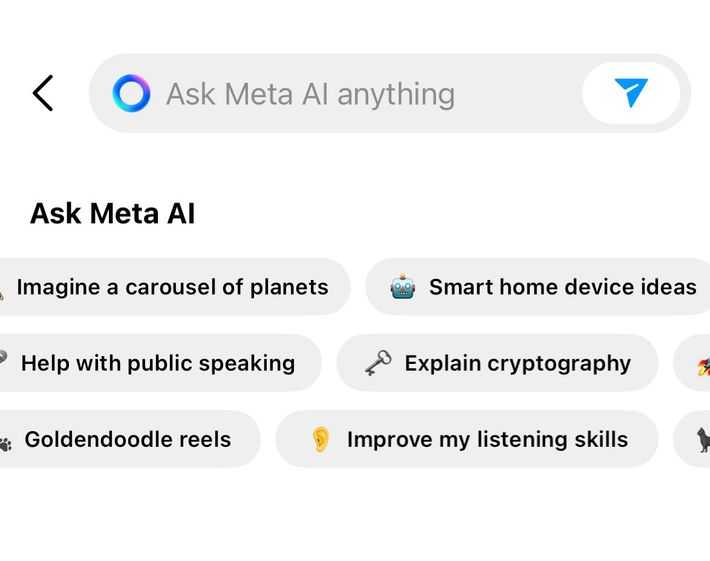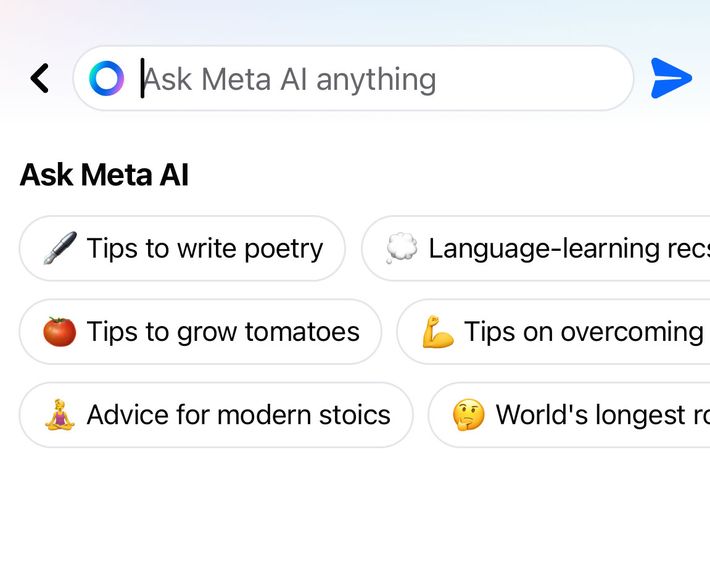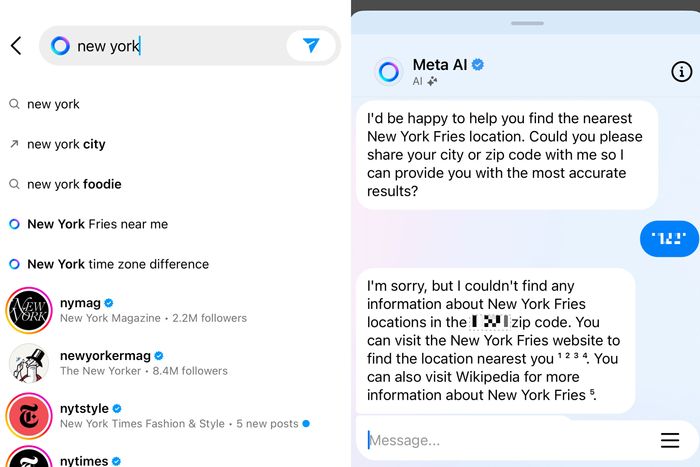
Meta has an idea: Instead of ever leaving its apps, why not stay and chat with a bot? This past week, Mark Zuckerberg announced an update to Meta’s AI models, claiming that, in some respects, they were now among the most capable in the industry. He outlined his company’s plans to pursue AGI, or Artificial General Intelligence, and made some more specific predictions: “By the end of the decade, I think lots of people will talk to AIs frequently throughout the day, using smart glasses like what we’re building with Ray-Ban Meta.”
Maybe so! But for now, the company has something else in mind. Meta is deploying its chatbot across its most popular apps, including Facebook, Instagram, WhatsApp, and Messenger. Users might encounter the chatbot commenting on Facebook posts, chiming in when tagged in group messages, or offering suggestions in social feeds. You can chat with it directly, like ChatGPT. It’ll generate images and write messages for you; much in the way that Microsoft and Google have built AI assistants into their productivity software, Meta has installed helpers into a range of social contexts. It’ll be genuinely interesting to see if and how people use them in these contexts, and Meta will find out pretty quickly.
This move has been described as both savvy and desperate. Is Meta playing catchup, plowing money into a fad, and foisting half-baked technology on its users? Or is Meta now the de facto leader in AI, with a capable model, a relevant hardware business, and more users than anyone else? Like AI models themselves, claims like these are hard to benchmark — every player in AI is racing in the same direction toward an ill-defined destination where they, or at least their investors, believe great riches await.
In actual usage, though, Meta’s AI tells a more mundane story about its intentions. The place most users are likely to encounter Meta’s chatbots most of the time is in the context of search:
Meta AI is also available in search across Facebook, Instagram, WhatsApp and Messenger. You can access real-time information from across the web without having to bounce between apps. Let’s say you’re planning a ski trip in your Messenger group chat. Using search in Messenger you can ask Meta AI to find flights to Colorado from New York and figure out the least crowded weekends to go — all without leaving the Messenger app.
This is both a wide and conspicuous deployment, in practice. The box used to search for other people — or pages, or groups, or locations, or topics — is now also something between a chatbot and a search engine. It looks like this:
Like ChatGPT, you can ask it about whatever you want, and it will synthesize a response. In contrast to some other chatbots, and in line with the sorts of results you might get from an AI-powered search engine like Perplexity or Google’s Search Generative Experience, Meta’s AI will often return something akin to search results, presented as a summary with footnoted links sourced from the web. When it works, the intention is pretty clear: Rather than providing something else to do within Facebook or Instagram, these features are about reducing the need to ever leave. Rather than switch out of Instagram to search for something on Google, or to tap around the web for a while, you can just tap Meta’s search bar and get your question answered there.
This isn’t a simple case of Meta maximizing engagement, although that’s surely part of it. Deploying this sort of AI, which is expensive to train and uses a lot of computing power to run, is almost certainly costing Meta a huge amount of money at this scale, which is why OpenAI charges users for similar tools. It’s also a plan for a predicted future in which the web — that is, openly accessible websites that exist outside of walled gardens like Meta’s — is diminished, harder to browse, and less central to the online lives of most people. Now, smartphone users bounce between apps and web browsers and use web browsers within apps. Links provide connective tissue between apps that otherwise don’t really talk to one another, and the web is a common resource to which most apps refer, at least somewhat. Here, Meta offers a preview of a world in which the web is reduced to a source for summarization and reference, less a thing that you browse than a set of data that’s browsed on your behalf, by a machine.
This wouldn’t be great news for the web, or the various parties that currently contribute to it; indeed, AI firms’ broadly rapacious approach to any and all existing and available sources of data could have the effect of making such data harder to come by, and its creators less likely to produce or at least share it (as currently built, Meta’s AI depends on results from Google and Bing). And let’s not get ahead of ourselves: the first thing I did when I got this feature on Instagram was type “New York,” which presented me with a list of accounts and a couple of suggested searches, including, curiously, “New York fries near me.” I decided to check it out:
Guess it’s a good thing I didn’t actually want any fries. Elsewhere, Meta’s AI is giving parenting advice on Facebook — claiming it’s the parent of a both gifted and disabled child who’s attending a New York City public school.
Maybe Zuckerberg’s right that we’ll be having daily conversations with AIs in our Ray Bans by the end of the decade. But right now, Meta is expecting us to have those conversations even if we don’t like, need, or understand what we hear back. We’re stuck testing the AI, and it us.
More screen time
- How Product Recommendations Broke Google
- The First AI Gadgets Are a Cautionary Tale
- On Truth Social, Trump’s Sad Mini-MAGA, It’s 2016 Forever

































